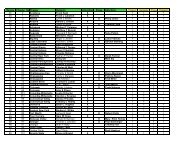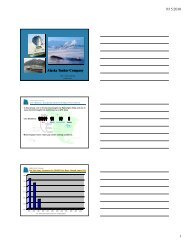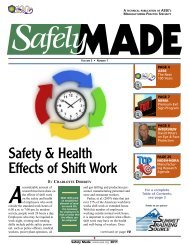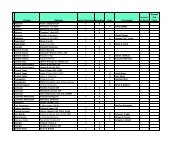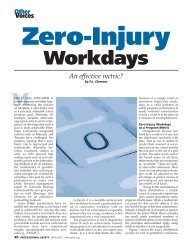Safety 2008 - ASSE - American Society of Safety Engineers
Safety 2008 - ASSE - American Society of Safety Engineers
Safety 2008 - ASSE - American Society of Safety Engineers
You also want an ePaper? Increase the reach of your titles
YUMPU automatically turns print PDFs into web optimized ePapers that Google loves.
Face toFacecontinuedfrom page 51buy-in <strong>of</strong> those segments that support ourgoals and objectives. Nothing is achievedin a vacuum, and success depends on thesupport <strong>of</strong> all the diverse populationsaffected by the decisions made.LR: Without diversity, we’re all redundant—sameideas, same solutions toproblems, no growth, little creativity, etc.A diversity pr<strong>of</strong>essional with a consumerproducts company tells an interestingstory. Just before her companylaunched a new food product line targetedat a specific ethnic group, the companydecided to consult members <strong>of</strong> this ethnicgroup within its organization. A specialtask force was formed and thanks to tappinginto its own diverse resources, theproduct line was a resounding success.PS: How do you work with, lead ormanage a diverse group and how doyou do so in an inclusive fashion?JA: Each individual is unique and hasa set <strong>of</strong> norms that drives him/her. Withthat understanding, I consider everyonewith whom I interact to be unique, and Iwork hard on my assumptions andremoving biases from my work. Withthat, I lead and encourage others to dothe same. I champion the concept <strong>of</strong>diversity and understanding to everyonewith whom I work and I hope this willlead to a greater understanding.DB: I consider all groups I work withas diverse. Every person’s opinion isimportant, and I encourage group membersto openly express themselves. I donot form judgments based on opinionsor views, and neither does the group.Instead, we work together to have anunderstanding <strong>of</strong> each individual’s perspectiveand create a solution that willsatisfy all. No one person has all theanswers. Conversations can get ratherheated, but that is expected when peopleare passionate about their beliefs. Theresults are a true reflection <strong>of</strong> everyoneinvolved.RM: This is very simple for me. I tryto follow the golden rule: “Treat others asyou would like to be treated.” For example,I like to be involved in decision makingand I let others participate in theprocess. I like to be heard and, therefore,let others express themselves. I like to bechallenged and <strong>of</strong>fered opportunities,and I continuously find ways to do thatwith those willing to accept challengesand opportunities. That said, the key isnot to force someone to do somethings/he doesn’t want to do but to create andmaintain an environment where individ-52 PROFESSIONAL SAFETY AUGUST <strong>2008</strong> www.asse.orguals can participate, make contributionsand be recognized for their efforts.LR: By trying to understand everyone’sstrengths and challenges and figuringout how to use them to accomplishobjectives. The key is to appreciate (notjust tolerate) the differences, and understandthat it’s not enough to inviteeveryone to the table. The environmenthas to be such that all members <strong>of</strong> agroup recognize the desire for and benefits<strong>of</strong> their contributions.PS: Why is diversity such a challenge?JA: Because people make it so. Because<strong>of</strong> wrong assumptions. Because <strong>of</strong>ignorance and lack <strong>of</strong> understanding andthe unwillingness <strong>of</strong> many—people, companies,groups and committees—toaccept our ever-changing world. Theworld is not big anymore. Advancementsin communication and technology havemade it easier for us to watch, learn andcommunicate with others, which has thenatural outcome <strong>of</strong> learning, understandingand appreciating others. To categorizeand place others in a box never leads toproductive results. Unfortunately, that’swhat <strong>of</strong>ten happens. To learn about othercultures and backgrounds, we have toabandon our comfort zone. If we do that,then we can begin to see the beauty andthe rewards <strong>of</strong> diversity.AG: There are many challenges inhandling diversity issues in big organizations.These include:1) Resistance to change. There arealways employees who will refuse toaccept the fact that the social and culturalmakeup <strong>of</strong> their workplace is changing.The “we’ve always done it thisway” mentality silences new ideas andinhibits progress.2) Implementation <strong>of</strong> diversity inthe workplace policies. This can be theoverriding challenge to all diversityadvocates. Armed with the results <strong>of</strong>employee assessments and researchdata, they must build and implement acustomized strategy to maximize theeffects <strong>of</strong> diversity in the workplace fortheir particular organization.Diversity in theSH&E Pr<strong>of</strong>ession<strong>ASSE</strong>’s Diversity Committee encouragesreaders to ask themselves thequestions posed in this interview.Consider how you will encouragediversity and inclusion in your personaland pr<strong>of</strong>essional life. TheDiversity Committee has taken a positiveapproach by establishing aDiversity Committee Scholarshipfund through the <strong>ASSE</strong> Foundation.What will you do? Share your ideasand action plans with the DiversityCommittee by sending an e-mail totwilkinson@asse.org.3) Successful management <strong>of</strong> workplacediversity. Diversity training aloneis not sufficient for any organization’sdiversity management plan. A strategymust be created and implemented to createa culture <strong>of</strong> diversity that permeatesevery department and function <strong>of</strong> theorganization, which is a big challenge.DB: Diversity is a big challengebecause it is impossible to understandeveryone’s point <strong>of</strong> view. Not everyone isexposed to diversity. While diversity isvaluable in obtaining a variety <strong>of</strong> information,it does cause conflicts because <strong>of</strong>opposing viewpoints. To overcome suchconflicts, we need to understand why wehave opposing viewpoints that are usuallya direct result <strong>of</strong> cultural and ethnicbackgrounds.Because cyberspace presents us soeasily with so many ideas and theexpansion <strong>of</strong> joint ventures throughoutthe world, we all must accept and learnto understand the differences in each <strong>of</strong>us to better communicate and grow.As individuals, many people do notunderstood or accept diversity and donot feel they need to. In some companies,it is a corporate problem not anindividual problem. Accepting diversityas a learned response takes time andeffort. To be a truly diverse world, it willtake time and education. Much <strong>of</strong> thechallenge to accepting diversity involvesgetting past the misunderstandings anddifferences that make us diverse in thefirst place.TN: One <strong>of</strong> the greatest challenges isgaining an understanding <strong>of</strong> diversity.In a meeting I attended when diversitywas being discussed, one member stated,“Well, we don’t have to addresswomen’s issues, since that is no longera diversity issue.” I thought the roomwould implode from the sudden intake<strong>of</strong> breath from the other committeemembers. Diversity is <strong>of</strong>ten reduced to ahead count or a checklist, without a trueinclusion or understanding <strong>of</strong> what theissues are. We need to create a greaterunderstanding <strong>of</strong> diversity in order togain a greater acceptance <strong>of</strong> our diversity.We need to come out <strong>of</strong> the DarkAges where the fear <strong>of</strong> something differentwas great, to accepting our differencesas a gift that enhances our world.LR: If by being a challenge we meanmaintaining diverse and inclusive environments,diversity is not a big challengefor many people. Such peoplehave invested efforts to understand howtheir lives can benefit from diversity andinclusion and in creating mechanismsthat support a diverse and inclusiveenvironment. For other people, diversityis a big challenge—and very much resisted—because<strong>of</strong> their misperceptionsabout consequences and benefits.



